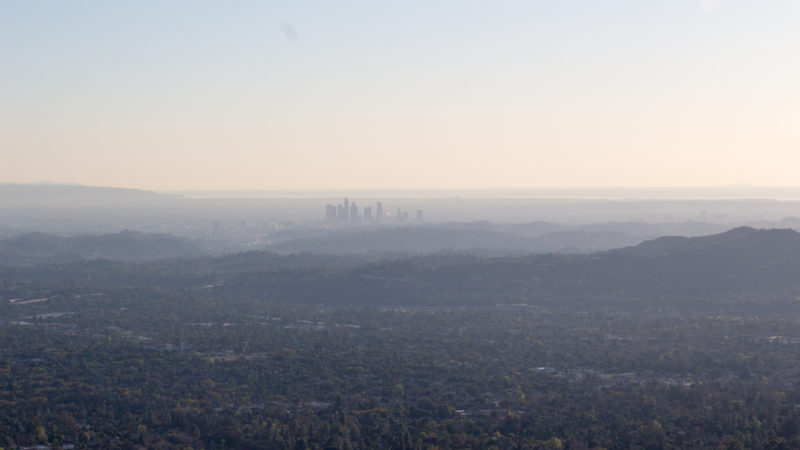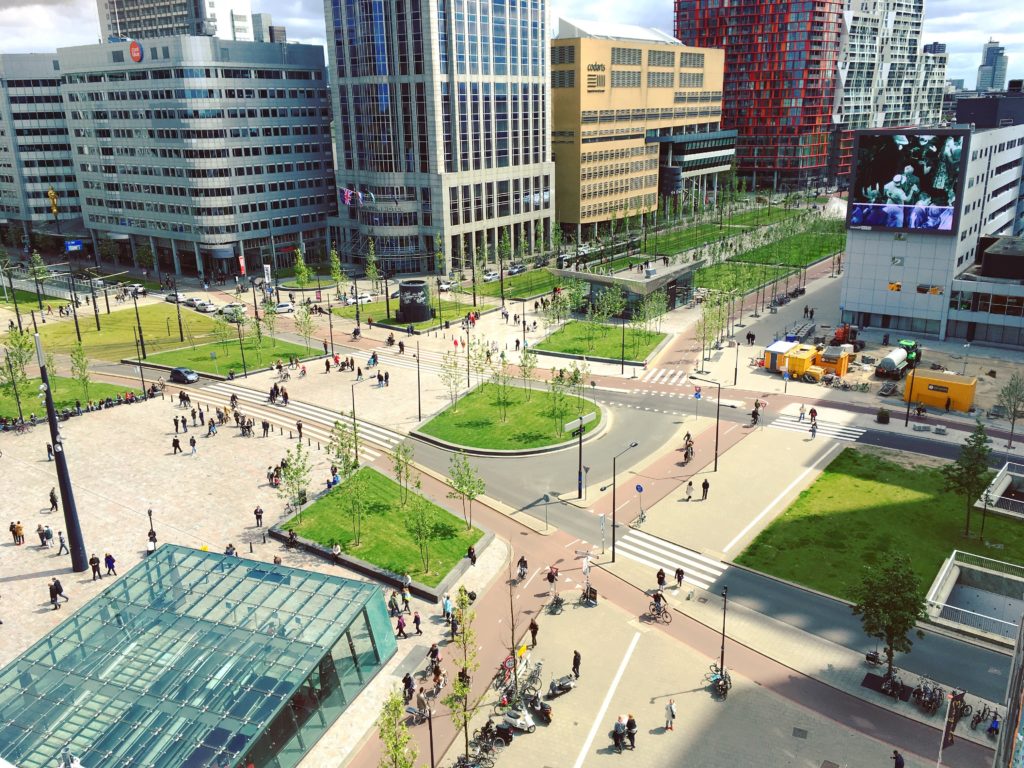
cities & towns, climate change, energy & technology, environmental justice, law & policy, nature & conservation
Post-carbon Cities – the Urgency of Now
Post-carbon Cities – The Urgency of Now
Dr. Stephanie Pincetl
Imagine for a second what a post carbon city means. Close your eyes. Open your ears.
There are no gas-powered engines, no lawn mowers buzzing and no leaf blowers braying. A bus whispers down the road, powered by a zero-emissions energy source like an overgrown Tesla.
The post carbon city is not only clean, but quiet – as quiet as a bicycle. You can hear birds. You can hear your own thoughts. When we imagine the ills of carbon powered fuels, we think of climate change and pollution. We forget about the damage from the roar of the engines. In recent years, noise pollution has been shown to cause a litany of health defects. As the population of cities balloons worldwide, the need for peace and quiet will grow more desperate.
Now open your eyes. While your ears bask in restorative quiet, you can take in the stunning architecture rooted in a sense of place. There will be solar panels on all plausible surfaces – roofs, yes, but also walls and eventually roads and cars. Buildings will be spun and oriented to capture the sun and channel cooling breezes. In warmer-climate cities, everything is white to reflect the heat and streets are narrower to cast shade. In northern cities, dark roofs capture the heat in winter. Efficient wood furnaces (or surplus solar energy) heat whole districts. Greenhouses and gardens are everywhere. And people walk.
These cities look very different from each other because we will have co-designed them with the local environment. Rainy Portland, Oregon relies on abundant local wood for its construction and heating while Chicago’s shore line is flanked with wind turbines and super-insulated buildings such as sod and other materials. Post carbon cities will have divergent evolutionary paths because our post carbon systems will be distributed and decentralized — emerging from local resources and place.
Post carbon cities are post-waste cities that confront the reality of our limited resources and overtaxed planet. Compost will be a way of life, as will sophisticated recycling and supply chain management. We no longer assume unlimited energy and planetary resources. We understand that our margin for resource extravagance is now razor-thin and that we can’t just override the constraints of natural systems by applying more brute carbon based energy. Earth resources are finite; its atmosphere sensitive. Instead, we recycle and repurpose as much as possible. Post carbon is about doing more — and better — with less.
Why imagine post-carbon cities?
More humans live in cities than anywhere else for the first time in human history – cities are our habitat. And cities are the drivers of Earth change. Today’s cities are almost completely reliant on carbon-based energy and its applications. Carbon fuels have enabled the dense conglomerations we live in.
That means the planet’s future starts with the remaking the city.
For many readers, sophisticated urban policy makers, and researchers, the “smart city” — reliant on sensors and automation, and “efficient” gadgets and machines — may often be confused as the future post carbon city. Let me tell you: it is not.
That smart city is highly material intensive, and inherently antidemocratic, both politically and culturally. In the “smart city,” things are done for you by programmers working for utilities or transit systems, or food companies. Smart cities make us dumb because critical decisions are embedded in those systems instead of being yours. Remember Wall-E? The 2008 Disney film featured a post-apocalyptic planet Earth, overrun by human waste and uninhabited but for a sole trash collecting little robot. All the humans evacuated to spaceships, where they live in smart cities that take care of all of their needs – including getting up from their chair.
“Smart cities” aren’t more efficient either. As the Jevons Paradox tells us, more efficiency too often simply leads to more energy use. So while your stuff – cars, toasters, and baby monitors, etc. may be more efficient, there’s more of it, and the cycle of resource consumption just accelerates. A sensor-saturated city distances you from daily life and the place you live — a fatal distance when your wellbeing relies on your environment and community. It’s like the people who depend on GPS and end up driving over a cliff.
We don’t need smart cities. We need intelligent ones, ones run by daily interactions and human decisions, by culturally driven choices about the use of information technologies.
This deep transformation will not be easy. Cities are choked with infrastructure, patterns, expectations, cultures and investments. Our urban fabric is obdurate and calcified; however, this evolution from smart to intelligent, from wasteful to post carbon, can emerge from what cities are best at — change and innovation. We have to decide that that is our future, together.
So what might this transformation to an intelligent city entail?
(1) Decapitalization – from commerce to wellbeing
Today, cities are predominantly about facilitating economic growth. Shifting away from a growth paradigm that devours Earth resources and carbon fuels is necessary if we are to lessen our impacts. Although a global economic slow-down is already happening — maybe not for ecological reasons – it demonstrates a saturation and fatigue, a desire for something more intangible in daily life than consumption: a desire for time, a desire for sociability and sharing—the share economy.
Let’s call this process of enhanced wellbeing decapitalization, the gradual repositioning of where the market fits best.
We need to develop new governance structures and new technologies to manage a decapitalized and decarbonized world. Instead of setting metrics for growth and consumption, we’ll have to generate waste from strategic repurposing of resources and energy. Our new government structures – including laws, policies and tax codes – will be designed to manage an integrated urban system that is complex and specific to place. The needs and economies of communities will vary based on climate, available resources and local demands. The challenge will be to decouple centuries of policy making and economic theory that posits that human wellbeing is predicated on endless growth. Instead, we need enhanced engagement in daily life from all of us — including the decisions about what is produced, by whom, for whom, why and how.
(2) Carbon Based Accounting + Human Purpose
We all know the perverse impacts of inequality — especially between rich and poor countries. The drain on resources comes from the less populated, wealthy parts of the world, while poorer countries suffer the brunt of climate change and resource scarcity. For deep transformation to take place, one of the preconditions is to understand that we are all in this together – that the conditions that exist today exacerbate income inequality such that there are individual fortunes that are many times larger than some county’s GDPs, not to mention the deepening income differences among people. It is very difficult to establish a common purpose of reduction of consumption to mitigate planetary impacts on such sloped playing field. Carbon accounts can speed the transition to increased equity by allocating resources fairly. Universal individual carbon accounting would radically level lifestyles across the planet. Scientists and experts say 2 tons per person per year is the limit of carbon that we can safely burn – although the US per capita hovers at more than 8 times that amount, at 19 tons per capita. How can individuals spend (essentially pool) their carbon accounts to acquire the goods they need? Carbon accounting would be a kind of new currency, and a carbon account would be a universal basic income – an idea that is gaining traction today as machines replace more and more human labor. Imagine carbon cards we swipe to spend energy and each expenditure that has embedded carbon. This accounting opens the door to dialogue about the changes we will need to make — within cities and on a global level — for well-being going forward.
The great myth is that people will be happy getting a check while machines do the work when the reality is that humans long for purpose, for a sense of greater meaning. Work is an important avenue for connection and fulfillment; the new work will be huge in repurposing and maintaining novel integrated urban systems. This is an opportunity for residents to regain agency in making cities and for large-scale problem solving.
(3) Time
Time itself will be more ample because post carbon things will take more time and life will move more slowly. Yes, renewable energy like solar may eventually produce the same power as carbon energy sources, but at a cost of portability. Renewable energy must generally be consumed close to its source, when generated; meaning renewable energy is less fungible into many different energy products and has different time dimensions. This slowing down – thank goodness – will extend to transportation, manufacturing, building, repurposing and recycling. The slowness of a post carbon city goes hand-in-hand with a fuller kind of human engagement. We will intentionally make and remake our place and our future in more collaborative ways. It’s an opportunity to make generous cities that are pleasant and offer welcoming open spaces, shade, cooperative work spaces and collaborative governance.

My vision is about the urgency of now and developing new pathways for the future. The idea that the post carbon future will simply mean a replacement of current carbon fuels with renewables in a seamless transition that most of us just watch happen and nothing changes —is a dangerous fantasy.
That fantasy — where technology and economic growth fuel smart cities that provide all the answers for us — won’t address the unsustainable extractive nature of the current economy and what is important for human wellbeing and happiness. And it won’t take us to a different future where humans recognize their dependence on planetary health and cycles, and cities are built to reflect that dependence. You might not like all of my ideas. But I suspect each of you found something that resonates compared to the current course of our cities.
The post carbon city is the key to planetary survival. If we shape it correctly, we transform ourselves and the course of Future Earth.
Edited by Homa Mojtabai
